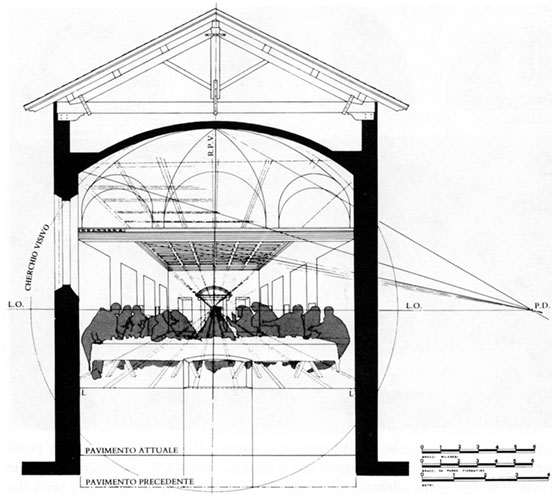| |
|
|
|
|
|
 |
|
|
|
Fig.9.8 Explanation of central projection used in Mantegna's Saint James Led to Execution (Figure 9.7)
|
|
So strongly does Hartt feel that he is looking at the painting from a low vantage point that he feels that his line of sight must be tilted upward, which is equivalent to tilting the image plane away from the vertical, which in turn implies the convergence of vertical lines at a vanishing point.
But he is mistaken. A low center of projection does not imply a tilted line of sight and image plane. To analyze the experience provided by Mantegna's fresco, let us briefly review the dilemma of perspective. Recall that some artists placed their pictures so that they would not be seen from the center of projection (as Donatello did in The Feast of Herod, Figure 7.1). We have argued that, if the scene contains rectangular objects, the viewer will experience the picture as if it were viewed from the center of projection. Mantegna placed the center of projection at eye level but designed the picture so that the single vanishing point would be below the bottom of the frame. In this way, a viewer who looked at the painting would feel that the implicit vantage point (the perceived center of projection) is at the high same as the true vantage point. At the same time, if a viewer's gaze was directed at right angles to the picture plane along the implicit principal ray, the viewer would be focusing on a point below the frame. To further emphasize the strangeness of this projection, observe that such a picture is hard to create by optical means: Suppose you wanted to simulate the picture-taking process underlying this fresco using a standard camera. The only thing you could do would be to stage the scene on a platform somewhat above eye level and to hold the camera at eye level, pointing neither up nor down, "looking" at a point below the top of the platform. Because the developed picture would cover a vertical field more than double the field covered by Mantegna's, it would then be necessary to crop it just above the horizon line (see Figure 9.8).9
In other words, Mantegna has created a discrepancy much more subtle than Donatello's enforced disjunction of the viewer's vantage point from the center of projection: He allows the viewer to stand at the center of projection and then implies inconsistent directions for the observer's line of sight and for the principal ray of the central projection. The viewer's unconscious inference implies a principal ray perpendicular to the image plane (in which case the viewer is looking at a wall), but the frame of the picture implies a visual axis at an oblique angle to the image plane (in which case the viewer is not looking at the horizon).
In Chapter 5, we discussed Leonardo's deep concern for the correspondence between the center of projection and the spectator's vantage point. To disregard this correspondence - he wrote - is tantamount to producing a perspective that would "look wrong, with every false relation and disagreement of proportion that can be imagined in a wretched work." And yet, as Leo Steinberg showed in a brilliant reexamination of the substance and form of Leonardo's Last Supper, Leonardo most blatantly - and successfully - violated his own rules.10
| |
|
|
|
|
|
 |
|
|
|
Fig.9.9 Leonardo da Vinci, The Last Supper (1495-8). Fresco. Church of Santa Maria delle Grazie, Milan.
|
|
We first look at Pedretti's analysis of the perspective of the fresco (see 9.9 Figures and 9.10). The perspective construction of the fresco is not perfect: Different sets of orthogonals converge at different points.
11 The center of gravity of the triangle defined by three points is assumed to be the vanishing point. Through the vanishing point the horizon line is drawn, labeled L.O. in Figure 9.10. The intersection of the present floor of the refectory with the picture plane is indicated by a line labeled and the level of the floor at Leonardo's time is marked by a line labeled
pavimento precedente. The center of projection (which is at the height of the horizon) is 4.6 m (or 15 ft. 1 in.) above today's floor. The distance point (at the intersection of the diagonals of the ceiling coffering, assumed to be made up of square coffers), labeled P.D., is 10.075 m (or 33 ft. 1 in.) from the vanishing point; therefore, the center of projection is 10.075 m, or between a quarter and a third of the length of the refectory away from the picture plane (Figure ). At that distance, the picture's angular dimensions are 46 by 26°. (To indicate a scale of angular measure, Pedretti has included a circle whose diameter subtends 60° when viewed from the center of projection; it is labeled
cerchio visivo.)
 |
|
|
|
|
|
|
Fig.9.10 Analysis of perspective construction of Leonardo's The Last Supper superimposed on a cross section of refectory.
|
Fig.9.11 Reconstructed plan and longitudinal elevation of room represented in Leonardo's The Last Supper, in relation to plan and elevation of refectory
.
|
